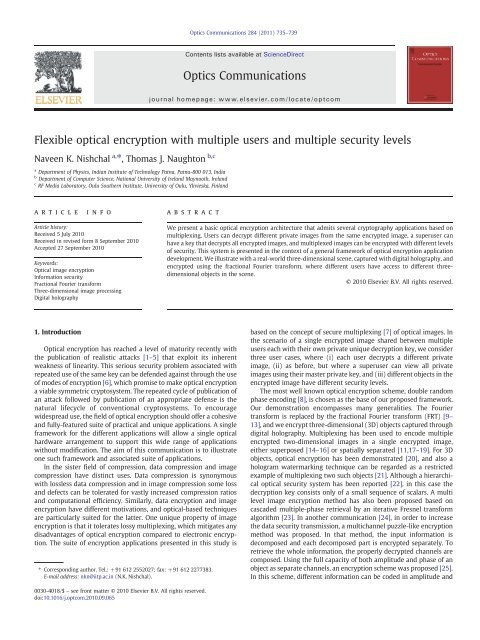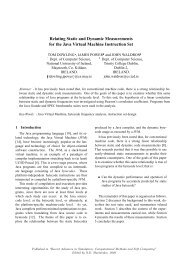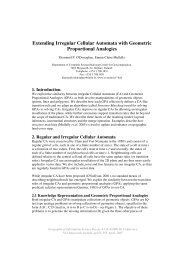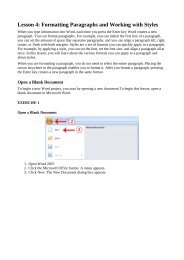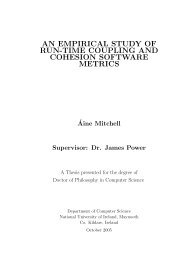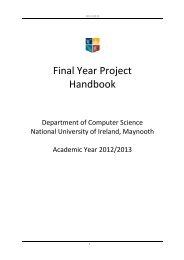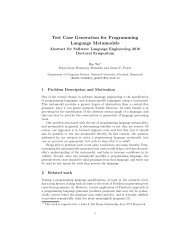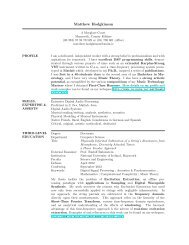Flexible optical encryption with multiple users and multiple security ...
Flexible optical encryption with multiple users and multiple security ...
Flexible optical encryption with multiple users and multiple security ...
You also want an ePaper? Increase the reach of your titles
YUMPU automatically turns print PDFs into web optimized ePapers that Google loves.
Optics Communications 284 (2011) 735–739<br />
Contents lists available at ScienceDirect<br />
Optics Communications<br />
journal homepage: www.elsevier.com/locate/optcom<br />
<strong>Flexible</strong> <strong>optical</strong> <strong>encryption</strong> <strong>with</strong> <strong>multiple</strong> <strong>users</strong> <strong>and</strong> <strong>multiple</strong> <strong>security</strong> levels<br />
Naveen K. Nishchal a, ⁎, Thomas J. Naughton b,c<br />
a Department of Physics, Indian Institute of Technology Patna, Patna-800 013, India<br />
b Department of Computer Science, National University of Irel<strong>and</strong> Maynooth, Irel<strong>and</strong><br />
c RF Media Laboratory, Oulu Southern Institute, University of Oulu, Ylivieska, Finl<strong>and</strong><br />
article<br />
info<br />
abstract<br />
Article history:<br />
Received 5 July 2010<br />
Received in revised form 8 September 2010<br />
Accepted 27 September 2010<br />
Keywords:<br />
Optical image <strong>encryption</strong><br />
Information <strong>security</strong><br />
Fractional Fourier transform<br />
Three-dimensional image processing<br />
Digital holography<br />
We present a basic <strong>optical</strong> <strong>encryption</strong> architecture that admits several cryptography applications based on<br />
<strong>multiple</strong>xing. Users can decrypt different private images from the same encrypted image, a superuser can<br />
have a key that decrypts all encrypted images, <strong>and</strong> <strong>multiple</strong>xed images can be encrypted <strong>with</strong> different levels<br />
of <strong>security</strong>. This system is presented in the context of a general framework of <strong>optical</strong> <strong>encryption</strong> application<br />
development. We illustrate <strong>with</strong> a real-world three-dimensional scene, captured <strong>with</strong> digital holography, <strong>and</strong><br />
encrypted using the fractional Fourier transform, where different <strong>users</strong> have access to different threedimensional<br />
objects in the scene.<br />
© 2010 Elsevier B.V. All rights reserved.<br />
1. Introduction<br />
Optical <strong>encryption</strong> has reached a level of maturity recently <strong>with</strong><br />
the publication of realistic attacks [1–5] that exploit its inherent<br />
weakness of linearity. This serious <strong>security</strong> problem associated <strong>with</strong><br />
repeated use of the same key can be defended against through the use<br />
of modes of <strong>encryption</strong> [6], which promise to make <strong>optical</strong> <strong>encryption</strong><br />
a viable symmetric cryptosystem. The repeated cycle of publication of<br />
an attack followed by publication of an appropriate defense is the<br />
natural lifecycle of conventional cryptosystems. To encourage<br />
widespread use, the field of <strong>optical</strong> <strong>encryption</strong> should offer a cohesive<br />
<strong>and</strong> fully-featured suite of practical <strong>and</strong> unique applications. A single<br />
framework for the different applications will allow a single <strong>optical</strong><br />
hardware arrangement to support this wide range of applications<br />
<strong>with</strong>out modification. The aim of this communication is to illustrate<br />
one such framework <strong>and</strong> associated suite of applications.<br />
In the sister field of compression, data compression <strong>and</strong> image<br />
compression have distinct uses. Data compression is synonymous<br />
<strong>with</strong> lossless data compression <strong>and</strong> in image compression some loss<br />
<strong>and</strong> defects can be tolerated for vastly increased compression ratios<br />
<strong>and</strong> computational efficiency. Similarly, data <strong>encryption</strong> <strong>and</strong> image<br />
<strong>encryption</strong> have different motivations, <strong>and</strong> <strong>optical</strong>-based techniques<br />
are particularly suited for the latter. One unique property of image<br />
<strong>encryption</strong> is that it tolerates lossy <strong>multiple</strong>xing, which mitigates any<br />
disadvantages of <strong>optical</strong> <strong>encryption</strong> compared to electronic <strong>encryption</strong>.<br />
The suite of <strong>encryption</strong> applications presented in this study is<br />
⁎ Corresponding author. Tel.: +91 612 2552027; fax: +91 612 2277383.<br />
E-mail address: nkn@iitp.ac.in (N.K. Nishchal).<br />
based on the concept of secure <strong>multiple</strong>xing [7] of <strong>optical</strong> images. In<br />
the scenario of a single encrypted image shared between <strong>multiple</strong><br />
<strong>users</strong> each <strong>with</strong> their own private unique decryption key, we consider<br />
three user cases, where (i) each user decrypts a different private<br />
image, (ii) as before, but where a superuser can view all private<br />
images using their master private key, <strong>and</strong> (iii) different objects in the<br />
encrypted image have different <strong>security</strong> levels.<br />
The most well known <strong>optical</strong> <strong>encryption</strong> scheme, double r<strong>and</strong>om<br />
phase encoding [8], is chosen as the base of our proposed framework.<br />
Our demonstration encompasses many generalities. The Fourier<br />
transform is replaced by the fractional Fourier transform (FRT) [9–<br />
13], <strong>and</strong> we encrypt three-dimensional (3D) objects captured through<br />
digital holography. Multiplexing has been used to encode <strong>multiple</strong><br />
encrypted two-dimensional images in a single encrypted image,<br />
either superposed [14–16] or spatially separated [11,17–19]. For 3D<br />
objects, <strong>optical</strong> <strong>encryption</strong> has been demonstrated [20], <strong>and</strong> also a<br />
hologram watermarking technique can be regarded as a restricted<br />
example of <strong>multiple</strong>xing two such objects [21]. Although a hierarchical<br />
<strong>optical</strong> <strong>security</strong> system has been reported [22], in this case the<br />
decryption key consists only of a small sequence of scalars. A multi<br />
level image <strong>encryption</strong> method has also been proposed based on<br />
cascaded <strong>multiple</strong>-phase retrieval by an iterative Fresnel transform<br />
algorithm [23]. In another communication [24], in order to increase<br />
the data <strong>security</strong> transmission, a multichannel puzzle-like <strong>encryption</strong><br />
method was proposed. In that method, the input information is<br />
decomposed <strong>and</strong> each decomposed part is encrypted separately. To<br />
retrieve the whole information, the properly decrypted channels are<br />
composed. Using the full capacity of both amplitude <strong>and</strong> phase of an<br />
object as separate channels, an <strong>encryption</strong> scheme was proposed [25].<br />
In this scheme, different information can be coded in amplitude <strong>and</strong><br />
0030-4018/$ – see front matter © 2010 Elsevier B.V. All rights reserved.<br />
doi:10.1016/j.optcom.2010.09.065
736 N.K. Nishchal, T.J. Naughton / Optics Communications 284 (2011) 735–739<br />
Fig. 1. Schematic of (a) the <strong>encryption</strong> system; FRT: fractional Fourier transform, RPM: r<strong>and</strong>om phase mask, <strong>and</strong> (b) the decryption system.<br />
phase, in such a way that an amplitude-authorized user can receive<br />
the phase encoding but <strong>with</strong>out the appropriate key is unable to read<br />
it.<br />
In a recent communication [26], a method of image <strong>encryption</strong> has<br />
been proposed that can encrypt a set of plaintexts into many similar<br />
ciphertexts. The phase keys corresponding to different plaintexts are<br />
achieved independently from the same designed ciphertext by<br />
cascade phase retrieval algorithm. In this paper, we present an <strong>optical</strong><br />
<strong>encryption</strong> architecture based on <strong>multiple</strong>xing, in which <strong>users</strong> can<br />
decrypt different private images from the same encrypted image, a<br />
superuser can have a key that decrypts all encrypted images, <strong>and</strong><br />
<strong>multiple</strong>xed images can be encrypted <strong>with</strong> different levels of <strong>security</strong>.<br />
We used a real-world three-dimensional scene, captured <strong>with</strong> digital<br />
holography, <strong>and</strong> encrypted using the FRT. To the best of our<br />
knowledge, this communication represents the first example of a<br />
generalized framework of <strong>multiple</strong>xed-based <strong>optical</strong> <strong>encryption</strong><br />
applications, <strong>and</strong> in addition the first example of using the FRT to<br />
encrypt 3D digital holographic objects.<br />
could be different 2D images, different 3D images, or different objects<br />
<strong>with</strong>in a 3D scene. They could be overlapping, non-overlapping,<br />
completely distinct, or could contain common parts. A schematic for<br />
the latter case is shown in Fig. 1(a). Although only three segments are<br />
shown, the principle holds for many segments. Each image segment is<br />
encrypted <strong>with</strong> a distinct r<strong>and</strong>om phase mask (RPM) placed in a<br />
fractional Fourier plane. The RPMs, fractional orders, or both can be<br />
distinct for each image segment. In Fig. 1(a), the 3D scene is<br />
represented by a complex-valued reconstruction (full Fresnel field)<br />
from an <strong>optical</strong>ly captured digital hologram. Conveniently, due to the<br />
speckle inherent in the digital holograms of macroscopic 3D scenes,<br />
the input plane RPM is not needed, but can be included in Fig. 1 in the<br />
case of real-valued or non-speckled inputs.<br />
2. Principle<br />
The principle of the <strong>multiple</strong>xing system is as follows. Several<br />
pieces of image data (let us call them image segments, denoted by I)<br />
are to be encrypted using different <strong>encryption</strong> keys. The segments<br />
Table 1<br />
Different user cases for the architecture in Fig. 1.<br />
User 1 User 2 User n<br />
User case Segment 1 Segment 2 Both segments<br />
(i) RPM 1 RPM 2 –<br />
(ii) RPM 1 RPM 2 f(RPM 1 ,RPM 2 ,RPM u )<br />
(iii) RPM 1 -– RPM2<br />
Fig. 2. Optical setup for hologram capture of real-world objects used in these<br />
experiments: BE, beam exp<strong>and</strong>er; BS, beam splitter; RP, retardation plate; <strong>and</strong> M,<br />
mirror.
N.K. Nishchal, T.J. Naughton / Optics Communications 284 (2011) 735–739<br />
737<br />
The <strong>security</strong> of an <strong>encryption</strong> technique depends on the size of the<br />
key used. An enlarged key space provides enhanced <strong>security</strong>. Various<br />
techniques [9,11,12] have been proposed to use the additional degrees of<br />
freedom offered by an <strong>optical</strong> system to enlarge the key size. Techniques<br />
based on the FRT provide such an example. A two-dimensional FRT,<br />
denoted g i (ξ i , η i ), of the image segment I i (x i , y i ), of order (α i1 =a i1 π/2) is<br />
given by [10]<br />
Here (x i , y i ) <strong>and</strong> (ξ i , η i ) represent the space <strong>and</strong> fractional<br />
domain coordinates, respectively, <strong>and</strong> K is a constant [10]. Asshownin<br />
Fig. 1(a), the function g i (ξ i , η i ) is multiplied by a RPM i defined<br />
as RPM i =exp[2πjr i (ξ i , η i )] <strong>and</strong> undergoes a further FRT of order<br />
(α i2 =a i2 π/2), giving<br />
e i ðρ i ; σ i<br />
Þ = K∬fg i ðξ i ; η i Þexp ½2πjr i ðξ i ; η i ÞŠg<br />
×exp jπ ξ2 i + η 2 i + ρ 2 i + σ 2 i<br />
tan α i2<br />
!<br />
−2jπ ξ iη i ρ i σ i<br />
dξ<br />
sin α i dη i :<br />
i2<br />
ð2Þ<br />
g i ðξ i ; η i<br />
Þ = K∬I i ðx i ; y i Þ<br />
×exp jπ x2 i + y 2 i + ξ 2 i + η 2 i<br />
tan α i1<br />
!<br />
−2jπ x iy i ξ i η i<br />
dx<br />
sin α i dy i :<br />
i1<br />
ð1Þ<br />
The function e i (ρ i , σ i ) is the encrypted function obtained due to I i . r i<br />
(ξ i , η i ) is an independent r<strong>and</strong>om function uniformly distributed in the<br />
interval [0,1). The coordinates (ρ i , σ i ) refer to the <strong>encryption</strong> domain<br />
Fig. 3. Simulation results. Intensities of (a) original complex-valued image reconstructed from a digital hologram, (b) <strong>multiple</strong>xed encrypted image, (c)–(e) decryption using the<br />
correct RPM <strong>and</strong> fractional orders of <strong>users</strong> 1, 2, <strong>and</strong> n, respectively.
738 N.K. Nishchal, T.J. Naughton / Optics Communications 284 (2011) 735–739<br />
coordinates. In the <strong>encryption</strong> plane, all n encrypted functions are<br />
<strong>multiple</strong>xed to generate a single encrypted image<br />
eðρ; σÞ = ∑ n i =1e i ðρ i ; σ i Þ: ð3Þ<br />
The encrypted image e(ρ,σ) will be shared among all the <strong>users</strong><br />
who will access it <strong>with</strong> different keys. The schematic for decryption is<br />
as shown in Fig. 1(b). The decryption is the reverse of the <strong>encryption</strong><br />
process <strong>and</strong> is done by using conjugates of the RPMs <strong>and</strong> inverse FRT.<br />
To decrypt the data correctly, one must specify the fractional domains<br />
in which the input, the <strong>encryption</strong>, <strong>and</strong> the output planes exist. Thus,<br />
in addition to the key used for <strong>encryption</strong> one must specify the orders<br />
of the FRTs relating them. A decryption using (RPM i , a i1 , <strong>and</strong> a i2 ) will<br />
decrypt only I i <strong>and</strong> all other segments will remain encrypted as a<br />
background white noise.<br />
This basic <strong>optical</strong> architecture can be manipulated to achieve<br />
several <strong>encryption</strong> functionalities, three of which are explained in<br />
Table 1. For illustration purposes, we refer to at most three <strong>users</strong> in<br />
each case, but there can be many more. In user case (i), we illustrate<br />
the concept of different <strong>users</strong> decrypting different images from a<br />
single encrypted image. To achieve this, as indicated in the first row of<br />
Table 1 <strong>and</strong> referring to Fig. 1, user 1 has RPM 1 , user 2 has RPM 2 , <strong>and</strong><br />
there is no user n in this case. The different RPMs encrypt different<br />
image segments that are <strong>multiple</strong>xed together. It can easily be seen<br />
that the two <strong>users</strong> will decrypt unique images from the encrypted<br />
image. In user case (ii), we illustrate the concept of a superuser. User 1<br />
has RPM 1 , user 2 has RPM 2 , <strong>and</strong> user n has RPM n that can decrypt all<br />
encrypted objects. This latter mask could be generated independently<br />
or generated as a function of the other phase masks, e.g. RPM n =f<br />
(RPM 1 ,RPM 2 ,RPM u ) where RPM u is known only to the superuser.<br />
(RPM u can be ignored if for one's application the superuser has no<br />
more privileges than the basic <strong>users</strong> combined.) The function f could<br />
be an efficient <strong>encryption</strong> attack algorithm based on simulated<br />
annealing [27]. The flexibility inherent in double r<strong>and</strong>om phase<br />
encoding has been shown previously [28].<br />
In user case (iii), we illustrate the concept of different images<br />
being encrypted <strong>with</strong> different levels of <strong>security</strong>. User 1 has RPM 1<br />
(many <strong>users</strong> can be given this key), there is no distinct user 2 in this<br />
case, <strong>and</strong> user n has an independent key RPM 2 that decrypts what<br />
RPM 1 decrypts plus some extra image data. The extra image data can<br />
be regarded as being encoded <strong>with</strong> a higher <strong>security</strong> level because<br />
only one decryption key in circulation can decrypt it. The image<br />
decrypted <strong>with</strong> RPM 1 can be regarded as being encoded <strong>with</strong> a lower<br />
<strong>security</strong> level because many <strong>users</strong> can decrypt it. Although in this<br />
example, there are only two <strong>users</strong> <strong>and</strong> two levels of <strong>security</strong>, the<br />
number of <strong>users</strong> <strong>and</strong> the number of different levels of <strong>security</strong> can of<br />
course be increased. The number of images that can be <strong>multiple</strong>xed<br />
together is bounded due to the noise that each incorrectly decrypted<br />
image will contribute to the decryption plane. Various techniques<br />
have been proposed to reduce this noise as much as possible [7,29,30]<br />
<strong>with</strong> up to 100 <strong>multiple</strong>xed digital holograms shown to be possible in<br />
some applications <strong>with</strong> acceptable crosstalk noise [30].<br />
3. Experiment<br />
We verify the proposed framework <strong>with</strong> a simulation using<br />
<strong>optical</strong>ly captured data. Our simulation adopts a general scenario of<br />
a real-world 3D scene that has been captured by inline phase-shift<br />
digital holography [31], rather than a collection of 2D images. Our<br />
procedure to capture the 3D scene as shown in Fig. 2 is the same as<br />
that described previously [32]. Fractional transforms have been used<br />
previously to reconstruct inline holograms [33]. The scene is<br />
encrypted so that the different <strong>users</strong> have access to (can decrypt)<br />
different 3D objects in the scene. Fig. 3(a) shows an intensity<br />
reconstruction from the 2048×2048 pixel <strong>optical</strong>ly captured digital<br />
hologram of a real-world 3D scene. The full complex field (not only<br />
the intensity) will be input to the <strong>encryption</strong> scheme. As illustrated in<br />
Fig. 1, there will be three <strong>users</strong> <strong>with</strong> access to different collections of<br />
objects. User 1 will have access to one bolt object, user 2 will have<br />
access to a different bolt object, <strong>and</strong> user n will have access to both<br />
objects. The fact that in our example some of the objects are spatially<br />
separated, <strong>and</strong> that there is only two of them, is not important. More<br />
objects, <strong>and</strong> overlapping segments, are possible. Research has<br />
commenced on automated segmentation of 3D objects from digital<br />
holograms [34].<br />
We r<strong>and</strong>omly generated two r<strong>and</strong>om phase masks independent of<br />
each other for encrypting the two image segments. We arbitrarily<br />
chose two fractional orders to be used <strong>with</strong> each RPM. An FRT (of<br />
order a 11 =0.25) of I 1 was calculated <strong>and</strong> multiplied <strong>with</strong> RPM 1 ,<br />
which was again fractional Fourier transformed <strong>with</strong> order a 12 =0.45.<br />
I 2 was transformed <strong>with</strong> an FRT of order a 21 =0.65 <strong>and</strong> RPM 2 was<br />
used in the fractional plane. The result was again fractional<br />
transformed <strong>with</strong> order a 22 =0.85 to get the encrypted image. For<br />
the third user, I 3 is the full 3D scene, <strong>and</strong> was encrypted <strong>with</strong> FRT<br />
orders a n1 =0.55 <strong>and</strong> a n2 =0.35 <strong>and</strong> phase mask RPM n (= RPM 1 +<br />
RPM 2 ). Now all the encrypted image segments were <strong>multiple</strong>xed<br />
together to get a single encrypted image, as shown in Fig. 3(b).<br />
The segments I 1 , I 2 , <strong>and</strong> I 3 decrypted <strong>with</strong> correct RPMs <strong>and</strong> correct<br />
fractional orders have been shown in Fig. 3(c)–(e), respectively. User<br />
case (i) is verified through Fig. 3(c) <strong>and</strong> (d), which depicts the<br />
different outputs of two <strong>users</strong>. User case (ii) is verified through Fig. 3<br />
(c)–(e), which depicts outputs of two <strong>users</strong> <strong>and</strong> a superuser,<br />
respectively. User case (iii) is verified through Fig. 3(c) <strong>and</strong> (e),<br />
which depicts outputs using two different <strong>security</strong> levels.<br />
4. Conclusion<br />
To summarize, an <strong>optical</strong> <strong>encryption</strong> architecture has been<br />
presented in which a real-world three-dimensional scene captured<br />
<strong>with</strong> digital holography is encrypted using fractional order Fourier<br />
domain r<strong>and</strong>om phase encoding, where different <strong>users</strong> have access to<br />
different three-dimensional objects in the scene. Users can decrypt<br />
different private images from the same encrypted image, a superuser<br />
can have a key that decrypts all encrypted images, <strong>and</strong> <strong>multiple</strong>xed<br />
images can be encrypted <strong>with</strong> different levels of <strong>security</strong>.<br />
Acknowledgement<br />
The authors thank Conor Mc Elhinney for capturing the holograms.<br />
Support is acknowledged from the Academy of Finl<strong>and</strong>, Science<br />
Foundation Irel<strong>and</strong> under the National Development Plan, <strong>and</strong> the<br />
European Commission through a Marie Curie Fellowship. The authors'<br />
email addresses are nkn@iitp.ac.in <strong>and</strong> tomn@cs.nuim.ie, respectively.<br />
References<br />
[1] A. Carnicer, M. Montes-Usategui, S. Arcos, I. Juvells, Opt. Lett. 30 (2005) 1644.<br />
[2] X. Peng, P. Zhang, H. Wei, B. Yu, Opt. Lett. 31 (2006) 1044.<br />
[3] Y. Frauel, A. Castro, T.J. Naughton, B. Javidi, Opt. Express 15 (2007) 10266.<br />
[4] A.M. Youssef, IEEE Signal Process Lett. 15 (2008) 77.<br />
[5] G. Situ, G. Pedrini, W. Osten, Appl. Opt. 49 (2010) 457.<br />
[6] T.J. Naughton, B.M. Hennelly, T. Dowling, J. Opt. Soc. Am. A 25 (2008) 2608.<br />
[7] B.M. Hennelly, T.J. Naughton, J.B. McDonald, J.T. Sheridan, G. Unnikrishnan, D.P.<br />
Kelly, B. Javidi, Opt. Lett. 32 (2007) 1060.<br />
[8] P. Réfrégier, B. Javidi, Opt. Lett. 20 (1995) 767.<br />
[9] G. Unnikrishnan, J. Joseph, K. Singh, Opt. Lett. 25 (2000) 887.<br />
[10] H.M. Ozaktas, Z. Zalevsky, M.A. Kutay, The Fractional Fourier Transform <strong>with</strong><br />
Applications in Optics <strong>and</strong> Signal Processing, Wiley, Chichester, 2001.<br />
[11] N.K. Nishchal, G. Unnikrishnan, J. Joseph, K. Singh, Opt. Eng. 42 (2003) 3566.<br />
[12] R. Tao, J. Lang, Y. Wang, Opt. Lett. 33 (2008) 581.<br />
[13] M. Joshi, C. Shakher, K. Singh, Opt. Lasers Eng. 46 (2008) 522.<br />
[14] G. Situ, J. Zhang, Opt. Lett. 30 (2005) 1306.<br />
[15] M.Z. He, L.Z. Cai, Q. Liu, X.C. Wang, X.F. Meng, Opt. Commun. 247 (2005) 29.<br />
[16] J.F. Barrera, R. Henao, M. Tebaldi, R. Torroba, N. Bolognini, Opt. Commun. 276<br />
(2007) 231.<br />
[17] X. Wang, D. Zhao, F. Jing, X. Wei, Opt. Express 14 (2006) 1476.<br />
[18] W. Jin, C. Yan, Optik 118 (2007) 38.
N.K. Nishchal, T.J. Naughton / Optics Communications 284 (2011) 735–739<br />
739<br />
[19] A. Alfalou, C. Brosseau, Opt. Lett. 35 (2010) 1914.<br />
[20] E. Tajahuerce, B. Javidi, Appl. Opt. 39 (2000) 6594.<br />
[21] S. Kishk, B. Javidi, Opt. Express 11 (2003) 874.<br />
[22] C.H. Yeh, H.T. Chang, H.C. Chien, C.J. Kuo, Appl. Opt. 41 (2002) 6128.<br />
[23] X.F. Meng, L.Z. Cai, Y.R. Wang, X.L. Yang, X.F. Xu, G.Y. Dong, X.X. Shen, H. Zhang, X.<br />
C. Cheng, J. Opt. A Pure Appl. Opt. 9 (2007) 1070.<br />
[24] D. Amaya, M. Tebaldi, R. Torroba, N. Bolognini, Opt. Commun. 281 (2008) 3434.<br />
[25] J.F. Barrera, R. Torroba, Appl. Opt. 48 (2009) 3120.<br />
[26] X. Yong-Liang, Z. Xin, Y. Sheng, C. Yao-Yao, Opt. Commun. 283 (2010) 2789.<br />
[27] U. Gopinathan, D.S. Monaghan, T.J. Naughton, J.T. Sheridan, Opt. Express 14 (2006)<br />
3181.<br />
[28] G. Situ, D.S. Monaghan, T.J. Naughton, J.T. Sheridan, G. Pedrini, W. Osten, Opt.<br />
Commun. 281 (2008) 5122.<br />
[29] X.F. Meng, L.Z. Cai, M.Z. He, G.Y. Dong, X.X. Shen, Opt. Commun. 269 (2007) 47.<br />
[30] M. Paturzo, P. Memmolo, L. Miccio, A. Finizio, P. Ferraro, A. Tulino, B. Javidi, Opt.<br />
Lett. 33 (2008) 2629.<br />
[31] I. Yamaguchi, T. Zhang, Opt. Lett. 22 (1997) 1268.<br />
[32] T.J. Naughton, Y. Frauel, B. Javidi, E. Tajahuerce, Appl. Opt. 41 (2002) 4124.<br />
[33] Y. Zhang, G. Pedrini, W. Osten, H.J. Tiziani, Opt. Lett. 29 (2004) 1793.<br />
[34] C.P. Mc Elhinney, J.B. Mc Donald, A. Castro, Y. Frauel, B. Javidi, T.J. Naughton, Opt.<br />
Lett. 32 (2007) 1229.


